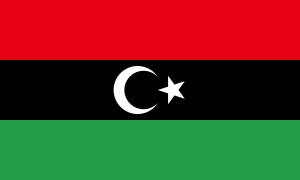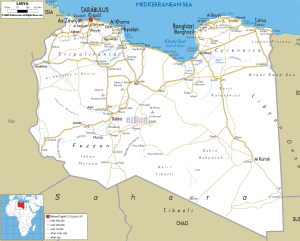This analysis is conducted as part of the Son of Media Safety & Security’s Project on War and Foreign Terrorist Organizations (FTOs). Learn more here.
Causes and Profile: Libya and The Libyan Civil War of 2011
With mergers and influences of the Phoenician, Carthaginian, Greek, Roman, Berber and Arab civilizations, the Libyan nation is nestled against the Mediterranean Sea and shares borders with Egypt, Tunisia, Algeria, Niger, Chad and Sudan. The region of Libya as well as the nation has always played vital roles in world history. The Ottoman Empire struggled to control Libya’s coast and interior during the nineteenth century. In 1911, Italy successfully invaded the coastal nation, but not without facing persistent insurgencies. During the Second World War, the land of Libya played important roles that would continue to support the British and American powers during the Cold War.
In 1951, the United Kingdom of Libya declared independence with King Idris al Sunussi at its head. Over the course of the next decade, King Sunussi would further centralize his government, ban political parties and finally declare a unitary monarchy, causing much infighting. The monarchy was also dependent heavily on foreign economic assistance as well as revenues generated by basing agreements with the United Kingdom and Unites States. The King’s financial woes would soon be resolved with the discovery of marketable oil in 1963, providing Libya with financial independence.
Although oil wealth brought some in Libya economic development, a growing pan-Arab socialist movement throughout the region along with criticism of the basing agreements with foreign powers, helped grow resentment against the King. Finally, in September 1969, as the King left the country to receive medical treatment, an army captain named Muhammad Qadhafi led a successful coup. This was the beginning of the forty-two year long brutal Qadhafi regime.
The Qadhafi regime would go on to continuously place itself at the crosshairs of western nations by not only supporting Soviet strategies across the world, but supporting anti-Western, anti-Israeli movements. Further, not only did the Qadhafi regime support terrorist groups and actions against Westerners, but directly committed such acts. Libya also pursued weapons of mass destruction (WMD) programs. The United States and other Western nations retaliated with military actions, economic sanctions and provided support to Libyan opposition groups.
In 2003 and 2004, Western sanctions and hostilities against Libya would ease in response to decisions by the Qadhafi regime to reverse the pursuit of WMD programs. Over the next six years, with oil sales and foreign investments on the rise as well as the world’s embrace of the new Qadhafi, Libya took very small steps towards freedom. A number of exiled political figures were permitted to return. Some political prisoners, some members of the Muslim Brotherhood and some Islamist militants such as members of the Libyan Islamist Fighting Group (LIFG) were freed from jail.
Revolution
Emboldened by the direction of Qadhafi’s reversals and hopeful of the benefits of openness to the outside world, some government officials began to propose reforms. Their demands centered on basic political rights and the drafting of a constitution. However, inaction and opposition to the proposed basic rights, news of the Arab Spring movements in neighboring Tunisia and Egypt, as well as more than four decades of brutal suppression created the environment for eventual revolution.
During February of 2011, motivated by the relatively (at the time) peaceful overthrows of Zine el-Abidine Ben Ali in Tunisia and Hosni Mubarak in Egypt and hopeful to duplicate results in Libya, eminent members of Libyan society as well as young Libyans began their protest efforts.
Demands for Qadhafi to step down came in many forms, including statements from human rights organizations and a signed statement by 213 prominent Libyans, including political activists, lawyers, students and government officials. Anonymous organizers also used Facebook and Twitter in order to promote a “Day of Rage” protest against Qadhafi’s regime. The protest was scheduled for 17 February across Libya, with its epicenter in Benghazi which had historically served as the quiet opposition headquarters to Qadhafi. Despite some of the organizers being jailed, the protest went on as scheduled.
The peaceful march on 17 February 2011 by unarmed protesters would soon be violently interrupted by pro-Qadhafi supporters. Reportedly supporters described as thugs and mercenaries wearing yellow helmets, begin attacking protesters in the street. Soon after reports of security forces shooting into the crowds begin to surface. Protesters are emboldened to continue as crowds grow larger and mass funerals are held on the streets of Benghazi.
Over the next three days as crowds grow larger, heavier weapons are used by the military in order to crush the protests. Further emboldened and aided by some members of the military switching sides, the protesters set their sites on the Benghazi Katiba, the military garrison. Every weapon at their disposal including stones, Molotov cocktails, small arms fire, bulldozers and improvised grenades are used to breach the Katiba. Finally a suicide bomber crashes a gate and protesters flood the perimeter on 20 February. It is reported that 207 are killed in what is now considered to be a revolution.
There are also other varying stories regarding which protests sparked the eventual overthrow of the Katiba. It is widely reported that anti-government rallies were being held on 15 February in Benghazi, in response to the arrest of human rights attorney Fethi Turbel. These rallies were reportedly met with water cannons and rubber bullets. Other reports claim that anti-government rallies on 15 February were aimed at drawing attention to the anniversary of a crackdown by Libyan forces on protesters outside the Italian embassy in 2006. Despite the fog on the origination of the protests, the outcome was indisputable, Qadhafi’s Benghazi had fallen.
War
Unorganized groups of victorious protesters now set their eyes on nation-wide liberation from Qadhafi forces. With defections and as government and military installations in Benghazi and other cities began to fall, protesters gained access to weapons depots. Freed political and religious prisoners, along with other citizens began forming armed militias to free Libya. However, such unorganized albeit determined forces proved unformidable against the more organized and better equipped Qadhafi forces.
Using state-run media, Qadhafi and his inner circle made several threatening statements backed by violence of action. While Benghazi was still controlled by the government, Qadhafi himself warned its citizens to “get ready, we are coming tonight to hunt for the scum and traitors … there will be no mercy.” Indeed for many protesters, there was no mercy. Reports of violent actions of the Qadhafi forces against civilians began to surface quickly. While the international community began debating possible actions and consequences in response, reports of violence, cleansing and indiscriminate killings grew. Western nations instituted travel bans, sanctions and the freezing of Qadhafi assets. The Arab League made statements in support of a United Nations Security Council (UNSC) resolution calling for a no-fly zone. The African Union made statements against foreign intervention on African soil.
On 17 March, 2011 the UNSC adopted Resolution 1973 establishing a no-fly zone to “take all necessary measures … to protect civilians and civilian populated areas under threat of attack in the Libyan Arab Jamahiriya … while excluding a foreign occupation force.”
On 19 March the United States, United Kingdom and France launched operations respectively codenamed, Operation Odyssey Dawn, Operation Ellamy and Operation Harmattan. The allied forces began to enforce a no-fly zone, destroyed portions of Libyan air defense network and attacked Qadhafi forces that posed threats to civilians.
On 30 March, NATO assumed command of allied operations under codename Operation Unified Protector. In April, military advisors were sent to aid rebels.
Rebels assisted by such international actions forced Qadhafi security forces and their supporters to begin retreating or moving into exile. Throughout operations, a steady flow of senior Qadhafi government and military figures abandoned their posts in protest of Qadhafi.
On 22 August, Tripoli fell and fighting moved to the Qadhafi family home of Sirte, where on 20 October, 2011 he was captured and killed.
Consequences
Initially the atmosphere in the newly liberated Libya was optimistic. The self appointed National Transition Council (NTC) began to work to establish a semblance of a government. However, the results of four decades of repression along with eight months of unchecked formation of armed militias, unsecured weapons controls and weak border enforcement began to place significant stumbling blocks. It was quickly realized that the armed militias were not disarming to go home and all were determined to have their interests represented.
It is important to place emphasis that this article is written on the Libyan Revolution of 2011 or the Libyan Civil War of 2011. Given the levels of violence and lack of governance, it is arguable that the civil war in Libya either never ended, or a second phase of the civil war began soon after the capture and death of Qadhafi.
The following is a list of the largest armed militias in the country:
- Al-Zintan Revolutionaries’ Military Council (umbrella for 23 separate militias)
- Al-Qaqa Brigade
- Al-Sawaiq Brigade
- Misrata Brigades
- 17 February Martyrs Brigade
- Ansar al-Sharia Brigade
Today, Libya seems to be following the post-revolution trend of falling deeper into the struggle between pro and anti Islamist forces. The U.S. Department of State describes Libya as a “terrorist safe haven.” Threats to government security forces, candidates for office and voters have made it extremely difficult to promote democratic processes.


